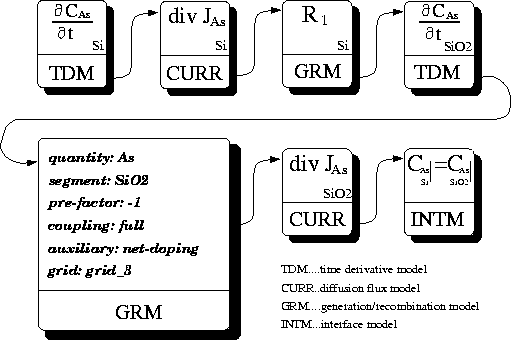Any specified model needs certain input data for being successfully evaluated. For example, if a point defect model should be applied to a silicon material segment, there must be silicon interstitials and vacancies available for the model setup. We have implemented an initialization function where the given input can be corrected, if necessary.
The structure of the implemented general diffusion equation which can be
treated by PROMIS-NT is given by (4.2-1), where ![]() and
and
![]() are prefactors determing the coupling between the quantities
are prefactors determing the coupling between the quantities ![]() .
.
It is possible to define ![]() generation/recombination terms
generation/recombination terms
![]() for each equation. The diffusion flux
for each equation. The diffusion flux ![]() can be
specified from predefined models (4.2-2) - (4.2-3). By using a
field enhancement model (4.2-3) only the diffusion coefficient
can be
specified from predefined models (4.2-2) - (4.2-3). By using a
field enhancement model (4.2-3) only the diffusion coefficient
![]() needs to be specified, the electrostatic potential
needs to be specified, the electrostatic potential ![]() as well
as the additional drift flux are calculated automatically. Furthermore,
there can be any diffusion current model designed which depends on the
parameters shown by (4.2-4).
as well
as the additional drift flux are calculated automatically. Furthermore,
there can be any diffusion current model designed which depends on the
parameters shown by (4.2-4).
If no special boundary conditions are specified for the diffusion equation, homogeneous Neumann boundary conditions (4.2-5) are assumed for all dopants at the outer geometry boundaries. Between the material interfaces one of the pre-defined interface models (see Section 4.4) can be chosen.
With a flexible modeling interface it is possible to specify the parts of the generic diffusion equation (4.2-1) which should be used on a given material segment. The structures of the diffusion equations including all modeling functions are entered in modeling tables, which are taken by the Universal Function Generator (UNFUG) [Fas94a] to be considered during the source code generation of the core initialization routines.
After defining the models for each solution variable, including the interface models and the boundary conditions, the internal representation of the physical models are built up. Thereby the model information from all equations is combined to one single-linked list of simulation models. Figure 4.2-4 outlines the structure of this model list. Each entry holds the whole information about the involved quantities, the physical parameters and the grid information in its own data structure.

Figure 4.2-4: Internal model list representation for the diffusion equations of
arsenic specified on two different material segments.
Once the model list is defined, it is kept constant during the whole simulation. The model queue is evaluated during the assembly of the linear system. Thereby the information in the model entries are used to apply the discretization scheme to the different parts of the diffusion equation.